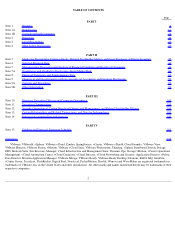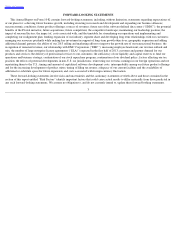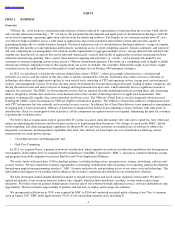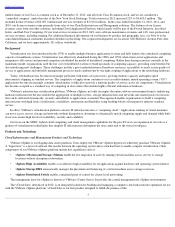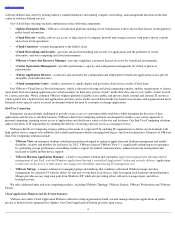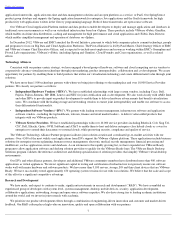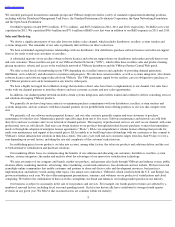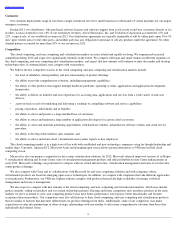VMware 2012 Annual Report Download - page 14
Download and view the complete annual report
Please find page 14 of the 2012 VMware annual report below. You can navigate through the pages in the report by either clicking on the pages listed below, or by using the keyword search tool below to find specific information within the annual report.
Table of Contents
Also, as more and more businesses achieve the virtualization of their data centers and other IT functions, the market for our VMware
vSphere product line may become saturated. If we fail to introduce compelling new features in future upgrades to our VMware vSphere product
line, develop new applications for our virtualization technology or provide product suites based on the VMware vSphere platform that address
customer requirements for integration, automation and management of their IT systems, demand for VMware vSphere may decline.
Due to our product concentration, our business, financial condition, results of operations, and cash flows would therefore be adversely
affected by a decline in demand for our data center virtualization products.
Additionally, in connection with the announcement in August 2012 of our latest product suite centered upon vSphere, we announced the
elimination of the virtualization-based entitlement to use vSphere that was based upon virtual memory, or vRAM. We had introduced the
vRAM-based entitlement with the release of our prior version of vSphere in the third quarter of 2011 but eliminated the entitlement in the third
quarter of 2012. Instead, when sold on a perpetual basis, vSphere will continue to license on a per-processor basis but without core, vRAM or
number of virtual machine limits. Although we currently do not expect the elimination of the vRAM entitlement to have a material impact upon
our revenues, there can be no assurance that revenues in future periods will not be materially and adversely affected due to the elimination of the
vRAM-based entitlement.
Our new product and technology initiatives subject us to additional business, legal and competitive risks.
Over the last several years, we have introduced new product and technology initiatives that aim to leverage our virtualization infrastructure
software products into the emerging areas of cloud computing and end-user computing as alternatives to the provisioning of physical computing
resources.
VMware’s strategy for the data center is to deliver the software-defined data center. In 2010, we introduced the first of our vCenter and
vCloud products, which we combined in 2011 with our vShield security product line to create our new Cloud Infrastructure and Management
(“CIM”)
Suite offering. In 2012, we delivered the vCloud Suite, which delivers a comprehensive suite for cloud computing in a single SKU with
simplified licensing.
In 2012, we acquired two companies that furthered VMware's SDDC strategy; we acquired Dynamic Ops, a provider of cloud automation
solutions that enable provisioning and management of IT services across heterogeneous environments, and Nicira, a developer of software-
defined networking and a leader in network virtualization for open source initiatives.
In connection with our 2009 acquisition of SpringSource, we announced our intention to use SpringSource solutions to extend VMware’s
strategy to deliver solutions in the emerging PaaS market and have since also acquired GemFire and RabbitMQ as part of our overall PaaS
strategy. Additionally, SpringSource’s current offerings and their underlying open source technology position us in the enterprise and web
application development markets. In 2011, we announced CloudFoundry, a VMware-operated developer cloud service and a new open source
PaaS project for the development of applications designed to utilize cloud computing, and in 2012, we announced that we planned to commit key
resources and programs, including SpringSource, GemFire and CloudFoundry to the Pivotal Initiative, a virtual organization that also includes
Big Data resources contributed by EMC.
We also continue to expand and enhance our end-user computing offerings, such as VMware View, and in 2012 announced the upcoming
Horizon Suite, a solution that is expected to provide end users with a single place to get access to their apps, data and desktops and give IT a
single management console to manage entitlements, policies and security. In 2012, we also acquired Wanova, a leading provider of intelligent
desktop solutions that centralize and simplify the management of physical desktop images while enabling users to take advantage of the native
performance of a PC.
Our acquisitions of Zimbra and Socialcast in 2010 and 2011 were a part of VMware’s strategy to enter the emerging SaaS market. In 2011,
we also acquired Digital Fuel, which provides IT financial and business management solutions.
The expansion of our offerings to deliver the SDDC and address IT management and automation, IaaS, PaaS and SaaS offerings subjects us
to additional risks, such as the following:
12
•
general economic conditions.
• These initiatives may present new and difficult technological challenges. Significant investments will be required to acquire and
develop solutions to those challenges. End users may choose not to adopt our new product or service offerings and we may be unable to
recoup or realize a reasonable return on our investments.
• Some of our new initiatives are hosted by third parties whom we do not control but whose failure to prevent service disruptions, or
other failures or breaches may require us to issue credits or refunds or indemnify or otherwise be liable to customers or third parties for
damages that may occur. Any transition of our services from a third party hosting service to our own data centers would also entail a
risk of service disruption during a transition. We may be subject to claims if customers of these service offerings experience service
disruptions or failures, security breaches, data losses or other quality issues.


